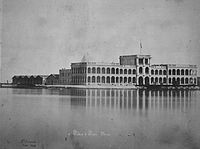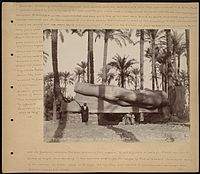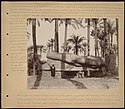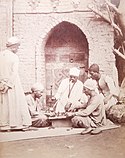Hippolyte Arnoux
| Hippolyte Arnoux | |
|---|---|
 | |
| Narození | 19. století Francie |
| Povolání | fotograf, fotoreportér a orientalista |
| Některá data mohou pocházet z datové položky. | |
Hippolyte Arnoux (aktivní asi v letech 1860 – asi 1890) byl francouzský fotograf a vydavatel působící ve městě Port Said na severu Egypta. Během 60. let 19. století dokumentoval budování Suezského průplavu a výsledné fotografie publikoval jako Album du Canal de Suez. Současně občas spolupracoval s bratry Zangakiovými, což byli dva řečtí fotografové vlastnící fotografické studio ve městě Port Said. Na konci 60. let se Arnoux stal partnerem Antonia Beata.
Galerie
Studiová fotografie egyptských žen a dětí, asi 1890
Egyptské ženy, 26,3 × 20,2 cm
Velká sfinga v Gíze, 1870–1900
Nizozemský hotel v přístavu Port Said
Socha Ramsese II.
Stavba Suezského průplavu, asi 1870
Loď Raffaelo Rubatino v Suezském průplavu
Odkazy
Literatura
- (francouzsky) Hippolyte Arnoux – photographe de l'union des mers (katalog výstavy), Centre historique des archives nationales, Paříž 1996
Související články
Externí odkazy
 Obrázky, zvuky či videa k tématu Hippolyte Arnoux na Wikimedia Commons
Obrázky, zvuky či videa k tématu Hippolyte Arnoux na Wikimedia Commons - (anglicky) Arnoux, Hippolyte
- (anglicky) Arnoux, Hippolyte
- (anglicky) Arnoux, Hippolyte (French photographer and publisher, active ca 1860-ca. 1890)
Média použitá na této stránce
Autor: Boston Public Library, Licence: CC BY 2.0
BPLDC no.: 08_04_000185
Page Title: Statue of Ramses II
Collection: William Vaughn Tupper Scrapbook Collection
Album: On the Nile. Cairo to Luxor.
Call no.: 4098B.104 v31 (p.4)
Creator: Tupper, William Vaughn
Photographer: Arnoux, Hippolyte
Genre: Scrapbooks; Albumen prints
Extent: 1 photographic print mounted on page : albumen ; page 33 x 39 cm.
Description: Scrapbook page contains one photograph of a statue of Rameses II with two men sitting in front of it.
Transcription: Sesostris discovering what had happpend took counsel instantly with his wife who had accompanied him to the feast and was advised by her to lay two of his sons upon the fire and so make a bridge across the flames whereby the rest might effect their escape. Sesostris did as she recommended, and thus while two of his sons were burnt to death, he himself and his other children were saved xxx. He left as memorials the stone statues which stand infront of the temple of Vulcan which represent himself and his wife and are about thirty cubits in height. These are the statues in front of which the priests of Vulcan many years after wound not allow Darius the Persian to place a statue of himself because they said Darius had not equalled the achievements of Sesostris in that Darius had failed to conquered the Seythians. Darius they said pardoned the freedom of the reply- Diodorus gives the answer of Darius, That he hoped not to be inferior to Sesostris if he lived so long. ...and its features resemble the other statues of this monarch. It was originally 42 feet high. Strabo mentions a statue of single stone standing in the entrance court before the temple of Ptah a Memphis. Herodotus spoke of two statues 30 cubits about 45 ft high. he says they were erected to commemorate an escape from assassination (see above)
Notes: Page title and description supplied by cataloger, derived from captions and/or annotated information; Caption on image: Ramses, Statue de Sesostria a Sakara Cote Ouest Caire N 717 ; Transcription continued from previous page.
BPL Department: Print Department
Rights: No known restrictions.(c) Tropenmuseum, part of the National Museum of World Cultures, CC BY-SA 3.0
De gevel op de foto werd door fotograaf Hippolyte Arnoux voor studioportretten gebruikt (Wieczorek & Sui, p. 113) en is voorzien van mashrabiyya, houten traliewerk.
(c) Tropenmuseum, part of the National Museum of World Cultures, CC BY-SA 3.0
Studioportret van twee gesluierde Egyptische vrouwen. De achtergrondschildering op deze foto werd door fotograaf Hippolyte Arnoux voor diverse studioportretten gebruikt (Wieczorek & Sui, p. 111).
Autor: Saulsogallery, Licence: CC BY-SA 4.0
An image by the photographer Hippolyte Arnoux apart of the SaulsoCollection of photography
















